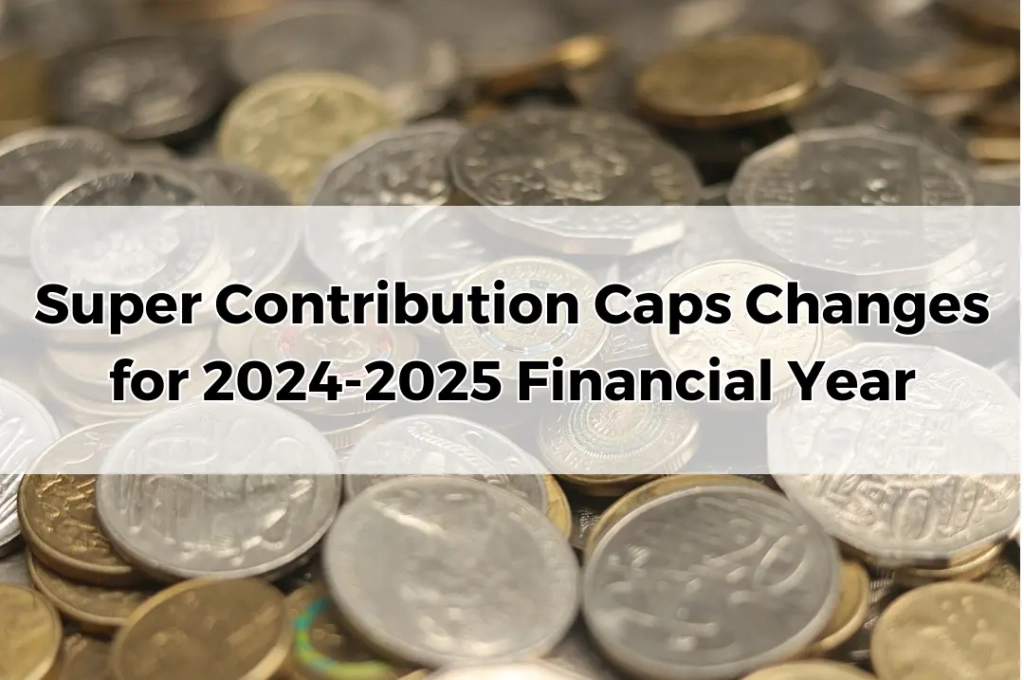Super Contribution Caps Changes for 2024-25 Financial Year
Table of Contents
ToggleIn the ever-evolving landscape of financial planning, staying abreast of the latest changes in superannuation regulations is not just beneficial—it’s imperative. This year, significant alterations in super contribution caps are poised to redefine the saving strategies for the 2024/25 financial year. Grasping these changes is crucial for anyone looking to optimise their financial future.
Understanding Superannuation
Superannuation, often termed as the bedrock of retirement planning, is more than just a financial safety net. It’s a proactive strategy, empowering individuals to accumulate wealth in a tax-effective environment. The essence of superannuation contributions, whether from individual savings, employer contributions, or government co-contributions, lies in their capacity to compound over time, paving the way for a secure financial future.
The Role of Contribution Caps
Contribution caps are pivotal, designed to balance the tax advantages of superannuation with equitable fiscal policy. The upcoming financial year heralds an increase in these caps: the concessional (before-tax) cap will escalate to $30,000, while the non-concessional (after-tax) cap will rise to $120,000. The ‘bring-forward’ rule, allowing for three years’ worth of contributions in a single year, will expand to $360,000. Understanding these caps—and the difference between concessional and non-concessional contributions—is fundamental to effective superannuation strategy.
Historical Perspective on Super Contribution Caps
Historically, the fluctuation of super contribution caps has mirrored the economic landscape, adapting to inflation, wage growth, and changing fiscal policies. A retrospective glance reveals a pattern of cautious increases, reflecting efforts to balance retirement savings incentives with broader economic stability. This historical context underscores the importance of current changes and their impact on long-term financial planning.
Changes in Concessional Contributions for 2024/25
The augmentation of concessional contribution caps is a game-changer for many, offering enhanced opportunities for tax-efficient retirement saving. This modification not only benefits individual savers but also imposes new considerations for employers, who must adapt their payroll and benefits frameworks accordingly.
Adjustments to Non-Concessional Contribution Caps
The elevation of non-concessional caps opens new avenues for individuals aiming to bolster their retirement savings independently of the tax advantages associated with concessional contributions. Savvy savers can now inject more funds into their super, leveraging the power of compounding to amass a larger nest egg.
Impact of the Cap Changes on Tax Planning
The recalibration of contribution caps significantly impacts tax planning strategies. It necessitates a re-evaluation of how individuals approach their super contributions, balancing the immediate tax benefits with the long-term goal of a prosperous retirement. Astute individuals will recalibrate their strategies to harness these new limits fully.
Super Cap Changes and Retirement Planning
The implications of these changes ripple through retirement planning paradigms, necessitating a strategic re-evaluation of long-term financial goals. Adapting to these new caps means potentially greater flexibility and opportunity for individuals to enhance their retirement readiness.
Case Studies: Before and After the Cap Changes
Illustrative scenarios reveal the practical impacts of these cap changes, offering a lens through which to view the adjustments in a real-world context. These narratives underscore the strategies that individuals might adopt to navigate the new landscape effectively.
Government's Rationale Behind the Changes
Unpacking the government’s intent reveals a multifaceted strategy aimed at enhancing the robustness of retirement savings while maintaining fiscal responsibility. These changes are anticipated to foster a more resilient economy and provide individuals with greater control over their retirement planning.
Industry Reactions to the New Caps
Feedback from the financial sector has been varied, with experts dissecting the potential ramifications of these adjustments. This feedback provides invaluable insights into the practical implications for both the industry and individual savers.
Compliance: What You Need to Know
Comprehending the compliance requisites is essential to avoid inadvertent breaches of the new caps. Awareness and understanding of these rules will ensure that savers can maximise their contributions without falling foul of the law.
Planning Strategies Under the New Caps
Strategic planning becomes paramount with the introduction of the new caps. Tailoring your superannuation contributions to align with these changes can significantly affect your financial well-being in retirement.
The Effect on High-Income Earners
High-income earners face unique considerations under the new framework, with specific strategies required to optimise the benefits of their increased contribution capacity.
Opportunities for Younger Savers
The revised caps present particular advantages for younger savers, who stand to benefit immensely from the power of compounding, provided they strategise their contributions effectively from an early age.
Navigating the Transition Period
Transitioning to the new caps can be seamless with the right guidance. Strategic adjustments and informed decision-making are key to capitalising on the changes without disruption to one’s financial trajectory.
Future Outlook: Predictions and Trends
Experts forecast ongoing adjustments in superannuation, anticipating future trends that could influence retirement planning. Staying informed and adaptable is crucial as the financial landscape evolves. These insights not only prepare us for immediate changes but also for long-term shifts in superannuation policies, ensuring that individuals can continuously align their saving strategies with the prevailing economic environment.
FAQs: Addressing Common Concerns
The myriad questions surrounding the new super contribution caps are as varied as they are pertinent. Providing clear, concise answers helps demystify the complexities of the changes, offering clarity and reassurance to those navigating this new terrain. This section aims to dispel myths, clarify ambiguities, and solidify understanding, ensuring that individuals are well-equipped to make informed decisions.
Tools and Resources for Effective Planning
In an era where information is power, having access to the right tools and resources is invaluable. Calculators, planning guides, and advisory services can play pivotal roles in helping individuals recalibrate their superannuation strategies to align with the new caps. These instruments not only aid in planning but also empower individuals with the knowledge to make decisions that best suit their long-term financial goals.
Conclusion
As we encapsulate the salient points of our discussion, the overarching message is clear: the changes to the super contribution caps are more than mere numerical adjustments—they are a beacon guiding us towards more robust retirement planning. Embracing these changes with informed strategies and a proactive mindset can turn the tide of your financial future towards greater security and prosperity.
The time to act is now. Engaging with a financial advisor, reviewing your superannuation strategies, and staying informed are crucial steps in leveraging the new super contribution caps to your advantage. Regular reviews and adjustments to your superannuation contributions, in tandem with expert advice, will ensure that your retirement savings grow in alignment with both your financial goals and the evolving legislative landscape. Your future self will thank you for the foresight and initiative taken today to secure a financially stable tomorrow.









